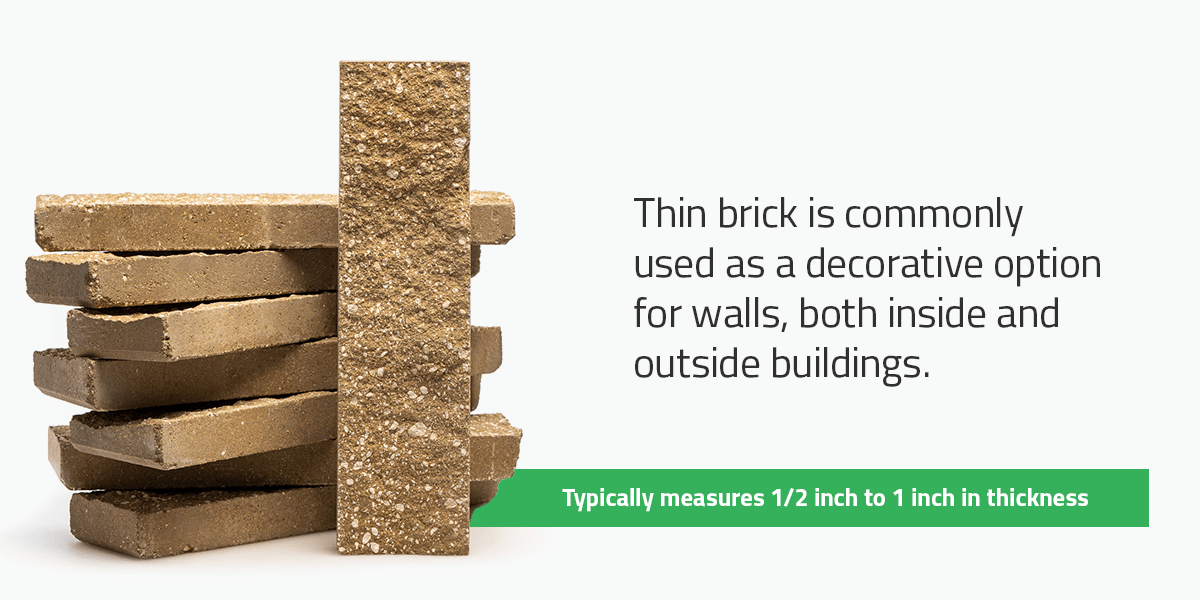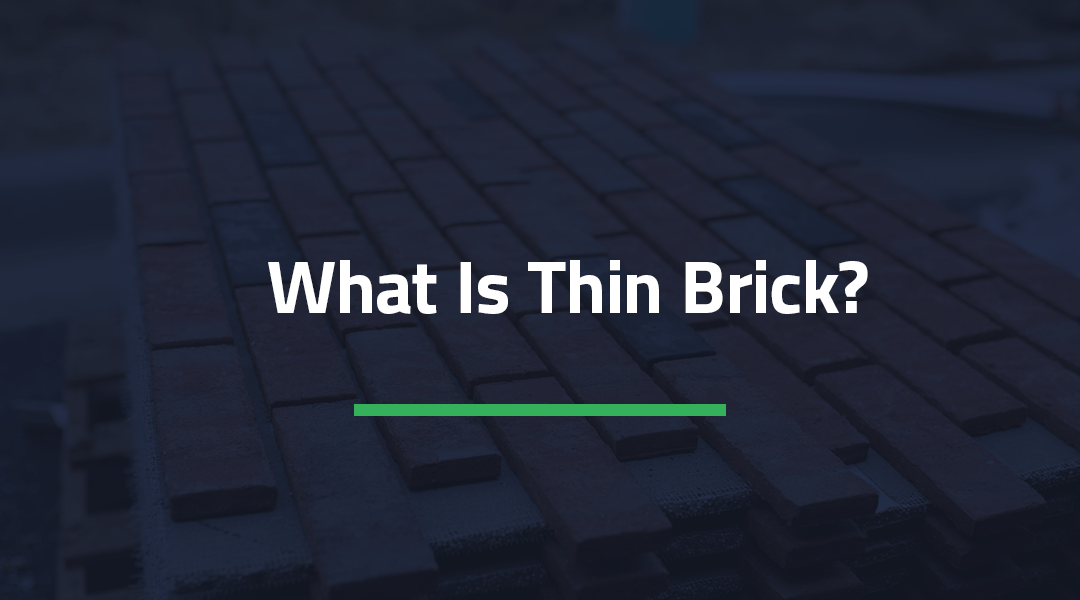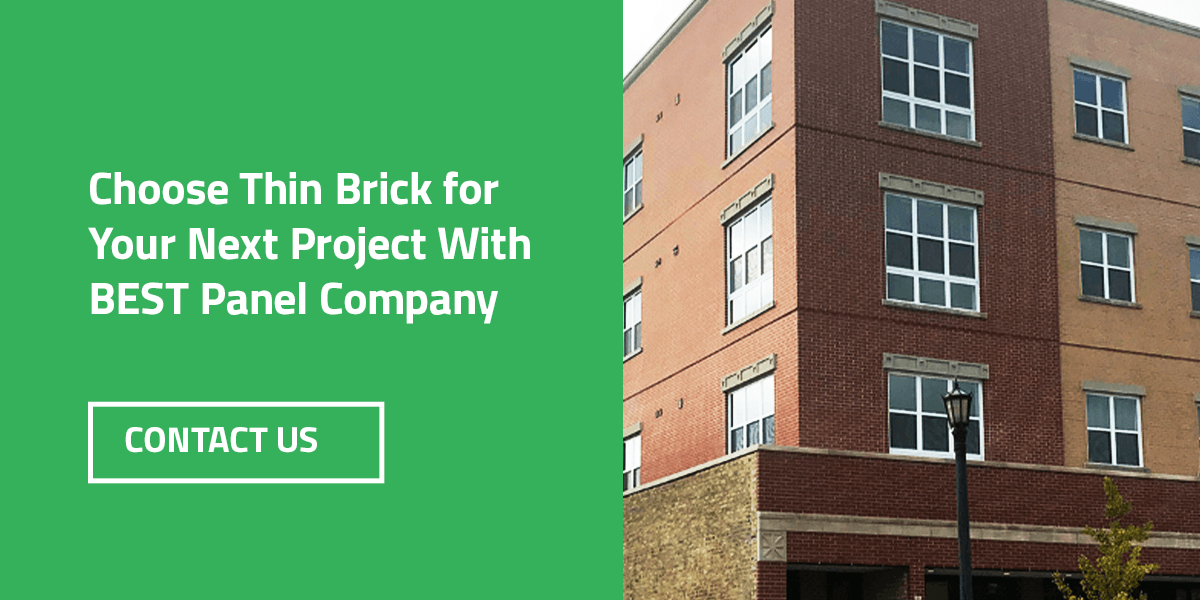Thin brick is a type of brick that is thinner and lighter than traditional bricks. For contractors or home renovators, they’re an easy way to improve efficiency and offer cost-effective solutions to clients. It’s important to stay informed about different renovation options when it comes to building materials.
Learn more about thin brick to explore its potential benefits compared to regular brick in terms of cost savings and ease of installation. Knowing what thin brick is, its different applications, cost differences and the labor requirements will help you assess whether incorporating it into projects can enhance both the aesthetics and bottom line of any project.
Thin Brick Veneer vs. Regular Brick
Thin brick is commonly used as a decorative option for walls, both inside and outside buildings. It’s made from the same materials as regular clay or concrete bricks but cut to be much thinner. It typically measures around 1/2 inch to 1 inch in thickness, making thin brick veneers a lightweight and versatile alternative to full-sized bricks with the same texture and look.
In contrast, regular bricks measure 3 5/8 inches deep. These bricks give walls and structures a solid framework in all types of buildings. Regular bricks are also used indoors and in interior spaces. It’s the look and feel of regular brick walls that made thin bricks grow in popularity among masons, contractors and renovators.

Thin Brick Applications
You can apply thin bricks to existing walls. It will create a classic look without the weight and structural requirements of regular bricks used in construction. Its versatility, availability in various colors and ease of installation make it a popular choice for adding a touch of warmth and texture to different spaces.
Common thin brick applications include:
- Interior applications: Thin brick adds a rustic look and unique texture to any indoor space. Create kitchen backsplashes, accent walls, serving counter fronts and even decorative ceilings without completely rebuilding walls.
- Exterior applications: A brick look can add a classic or industrial look to enhance a structure’s appearance. Use it for exterior columns, sidings, patios and façades.
- Fireplaces: Arrange thin bricks in different patterns to create a beautiful and durable fireplace.
- Flooring: Typically used in high-traffic areas, thin bricks make up the flooring material in entryways and commercial spaces.
- Landscaping: Provide an aesthetic option for walkways, sidewalks, stairways and garden walls.
Installation of Thin Bricks Compared to Regular Bricks
Once thin brick installation is complete, it looks indistinguishable from a regular brick wall. When comparing thin brick vs. regular brick cost, consider the amount of time and material you’ll need to complete a project. Thin bricks need fewer materials and less specialized labor compared to regular bricks. Instead of building an entire wall, you apply thin bricks with mortar or adhesives over an existing wall. These surfaces can include drywall, plywood and concrete.
Even the average person can install brick veneer. Unlike regular brick installations that are more labor-intensive and need structural support, contractors can complete thin brick projects quickly and efficiently with minimum disruption to clients.
Benefits of Thin Brick
In addition to easy installation and cost-effectiveness, other thin brick benefits include:
- Wide range of colors and finishes: Thin brick offers a classic brick look with a modern twist. It’s easy to customize thin brick projects with versatile design options.
- Durable and low maintenance: Since thin brick is made of fired clay, it provides an additional layer of protection against weather conditions and wear and tear. No need for frequent repairs or replacements. Cleaning with mild detergent and water is sufficient for routine maintenance.
- Lightweight: Compared to regular brick, thin bricks weigh less, which makes them easier to handle, transport and install.
- Insulation: Thin bricks may be thinner, but they provide extra insulation. This improves the energy efficiency of the interior space.
- Energy-efficient: Thin brick is an environmentally responsible choice in projects. They require no steel lintels or brick ledges, use 80% less mortar to install and contain 80% less shale and clay.
Frequently Asked Questions
Below are a few common questions about thin brick products and installation practices.
Can Thin Brick Be Used on Floors?
Although it’s more common for wall applications, thin brick can also be used on floors. Its durability is ideal for areas with heavy foot traffic when you need flooring material to last against cracking, chipping and fading. Additionally, thin brick floors are easy to maintain and provide cool floor temperatures while giving the space a warm and rustic look and feel. Overall, brick flooring, whether you use thin brick or regular brick, is more cost-effective than natural stone and ceramic tile floor installations.
How Durable Is Thin Brick?
Thin brick’s durability is similar to that of regular brick, even though they weigh much less. Compared to other structural materials, thin brick can withstand fading, rotting, warping, insect infestation, cracking and chipping. There is no compromise on its strength due to its thinness. Also, thin bricks are easy to clean and maintain indoors and outdoors, making it a popular choice among builders and a long-lasting and cost-effective investment for renovators.
How Thick Is Thin Brick?
Thin bricks measure around 1/2 inch to 1 inch in thickness, whereas regular bricks measure 3 5/8 inches deep. Both types of bricks are made from similar materials. However, since thin bricks are thinner and more lightweight to their regularly shaped counterparts, they’re a popular choice for home renovation projects in achieving the same texture and look.
Your content goes here. Edit or remove this text inline or in the module Content settings. You can also style every aspect of this content in the module Design settings and even apply custom CSS to this text in the module Advanced settings.
Can Thin Brick Be Used Outside?
Thin bricks are versatile, which means they can be used in most interior and exterior applications. Thin bricks can be used on any structure that may not be able to support the weight of regular bricks. Some examples of where thin brick can be used outside include:
Wall Thin Brick
- Exterior columns
- Sidings
- Façades
- Outdoor fireplaces
- Garden Walls
Floor Thin Brick
- Patios
- Commercial Flooring
- Walkways
- Sidewalks
- Stairways
- Landscaping
- Exterior pavements
Choose Thin Brick for Your Next Project With BEST Panel Company
Thin brick is a cost-effective, lightweight alternative to regular brick, saving you time and money in construction and renovation projects. We serve most markets with numerous brick suppliers with hundreds of colors in stock, ready to ship from our central location in Hardinsburg, KY. Our thin bricks are made of fired clay real brick, environmentally friendly and have a 25-year warranty.
We are passionate about our products and could talk about it all day, but we love to let our projects speak for themselves. For more information about our products and pricing, contact our team online and we will contact you as soon as possible.



Recent Comments